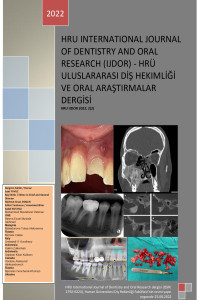Management Of Oral Ranula With Modified Micro-Marsupialization
Management Of Oral Ranula With Modified Micro-Marsupialization
Ranula, Minimally Invasive Treatment, Micro-marsupialization,
___
- P. Rachana, R. Singh, and V. Patil, “Modified micro-marsupialization in pediatric patients: A minimally invasive technique,” SRM J. Res. Dent. Sci. 2018;9(2):83.
- M. C. Piezzatta, T. C. Pereira, and M. J. Amenebar, “Micro‐marsupialization as an alternative treatment for mucocele in pediatric dentistry,” Int. Pediatr. Dent. 2012;22: 318–323.
- R. Chauhan Singh, V. Chauhan Singh, D. Shirol, and G. Lele, “Ranula in an Adolescent Patient,” J. Dent. Allied Sci. 2014;3(2):105–107.
- C. A. M. Goodson, B. F. K. Payne, K. George, and M. McGurk, “Minimally invasive treatment of oral ranulae: adaptation to an old technique,” British J. Oral Maxillofac. Surg. 2015;53:332–335.
- D. Kokong, A. Iduh, I. Chukwu, J. Mugu, S. Nuhu, and S. Sugustine, “Ranula: Current Concept of Pathophysiologic Basis and Surgical Management Options,” World J. Surg., vol. 41, no. 6, pp. 1476–1481, 2017.
- S. Hegde, B. Ketan, and D. Rao, “Management of Ranula in a Child by Modified MicroMarsupialization Technique,” J. Clin. Pediatr. Dent. 2017;41(4):305–307.
- B. Aluko-Olokun and A. A. Olaitan, “Ranula Decompression Using Stitch and Stab Method: The Aluko Technique,” Journal of Maxillofacial and Oral Surgery. 2017; 16(2): 192–196.
- A. Hills, A. Holden, and M. McGurk, “Evolution of the management of ranulas: change in a single surgeon’s practice 2001-14,” British Journal of Oral and Maxillofacial Surgery. 2016;54(9):992–996.
- S. Y. Chung, Y. Cho, and H. B. Kim, “Comparison of outcomes of treatment for ranula: a proportion meta-analysis,” Br. J. Oral Maxillofac. Surg. 2019;57:620–626.
- Başlangıç: 2021
- Yayıncı: Harran Üniversitesi
Süt Dişlerinde Direkt Pulpa Kaufaj Tedavisi
ERGENLİK ÇAĞINDAKİ ÖĞRENCİLERİN BESLENME İLE DİŞ SAĞLIĞI ARASINDAKİ İLİŞKİNİN İNCELENMESİ
Mehmet Sinan DOĞAN, Zelal ALMAK, Maksut CENGİZ, Sedef KOTANLI
LUMBAR DİSK HERNİSİ OPERASYONLARININ ENDOTRAKEAL KAF BASINCINA VE TRAKEAL MORBİDİTEYE ETKİSİ
Yusuf İPEK, Zeynep BAYSAL, Enes ÇELİK, Hakan AKELMA
Management Of Oral Ranula With Modified Micro-Marsupialization
Zülfikar KARABIYIK, Mahmut Sami YOLAL, Mohammad Nabi BASİRY
Kübra CERAN DEVECİ, Yasin ÇİÇEK, Abdulsamet TANIK
Büşra KARAAĞAÇ ESKİBAĞLAR, Buket AYNA
Bibliometric Analysis of Turkish Endodontic Journal
Treatment of Eagle’s Syndrome By Intended Fracture of The Styloid Process: Report of Two Cases
Meriç DEVELİ, Öznur ÖZALP, Alper SİNDEL
Evaluation of CFR-PEEK Miniplates with Finite Element Analysis in Mandibular Angle Fracture
